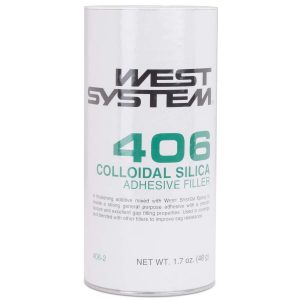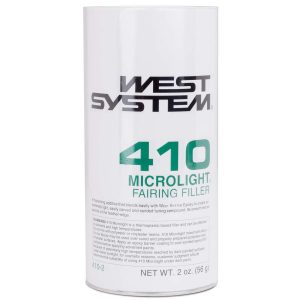 Selecting Epoxy Fillers
Selecting Epoxy Fillers
As a rule, use WEST SYSTEM higher-density epoxy fillers when bonding higher-density materials such as hardwoods and metals. Any of the adhesive fillers are suitable for most bonding situations. Your choice of a filler for general use may be based on the handling characteristics you prefer. Fillers may also be blended together to create mixtures with intermediate characteristics.
Adhesive Fillers vs. Fairing Fillers
WEST SYSTEM fillers are used to thicken the basic epoxy resin/hardener mixture for specific applications. Each filler possesses a unique set of physical characteristics, but they can be generally categorized as either Adhesive (high-density) or Fairing (low-density). Adhesive filler mixed with epoxy cures to a strong, hard-to-sand plastic useful in structural epoxy applications like bonding, filleting and hardware bonding. Fairing filler mixed with epoxy cures to light, easily sandable material that is generally used for cosmetic or surface applications like shaping, filling or fairing.
Epoxy Fillers and Epoxy Strength
While certain fillers will increase the density of epoxy, this does not correlate to higher physical properties or increased adhesion strength. Epoxy is strongest without filler added to it, but adhesive fillers are excellent for increasing the viscosity of the epoxy mixture, bridging gaps, preventing the epoxy from soaking too far into the wood, and preventing glue-starved joints. Fairing fillers turn the epoxy into an easily sanded fairing compound.
Bonding with Fillets
Gluing plywood structures together with epoxy fillets saves considerable time constructing the joints and reduces overall weight of the structure compared to more traditional methods using wooden cleats and screws. The strength and gap-filling qualities of epoxy eliminate the need for precisely fitted wood cleats that otherwise require time and skill to create. When gluing with conventional adhesives, that are non-gap filling such as resorcinol glue, wood cleats need to be well fitted, need to be wide enough to provide sufficient glued surface area and provide enough thickness for screws to be driven into. Building with epoxy fillets is especially beneficial when attaching bulkheads to hull sides, attaching hull sides to hull bottoms where the faces of the plywood are coming together at ever-changing angles.
When you use adhesive fillers, or high-density fillers, to thicken epoxy to a non-slumping consistency it can bridge large gaps in wood joints, without loss of strength, thus saving a great deal of time labor otherwise needed to create a strong joint.



